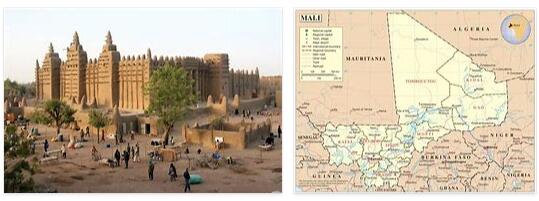Mali, officially French République du Mali [repy Republic dy ma li], German Republic of Mali, landlocked country in West Africa with (2019) 19.7 million residents; The capital is Bamako.
Mali borders Algeria to the north, Niger to the east, Burkina Faso and the Republic of Ivory Coast to the south, Guinea to the southwest, Senegal and Mauritania to the west.
Inland Mali is the largest country in West Africa in terms of area; it extends from the Upper Guinea Sill over the Niger Basin to the central Sahara. Wide plains (slate and sandstone panels) and flat basins characterize the landscape. The desert-like northeast of Mali is dominated by the crystalline mountain massif Adrar des Iforas (up to 835 m above sea level). The mountain ranges south of the Niger arc have the highest elevation in the country with the witness mountain Hombori Tondo (1,155 m above sea level). The central and southern parts of the country are crossed by Niger (1,754 km in Mali) and Senegal (850 km). Between Ségou and Timbuktu the Niger forms a huge inland delta; there it floods a land area of around 40,000 km 2 for three to four months a year, leaving behind fertile alluvial land.
Malikites
Malikites, Malekites, followers of one of the four schools of law ( madhhab ) of Sunni Islam. Theschool of law, whichemerged in the 8th century and named after Malik Ibn Anas, particularly emphasizes thecustomary law createdby the Idjma, but also allows one’s own judgment. The school of law originated in Medina and spread across Egypt in North Africa and Islamic Spain. There it ousted Shiite and Zahirite ( Zahirite ) currents. The main works were written by Sahnun († 854) and Ibn Ruschd. The Malikites are common in the Islamic areas of Africa and on the east coast of the Arabian Peninsula.
Kayes
Kayes [English ke ɪ z, French kaj], capital of the region of the same name in Mali, in the west of the country, on Senegal, which is navigable from here (July – October), (2009) 126,300 residents.
Catholic bishopric; Market center (cattle and sheep trade); Transport hub on the Dakar – Bamako railway line; Ferry service.
Kayes is one of the hottest places on earth; the mean monthly temperature maxima are between 31 ° C (in August; wettest month) and 42 ° C (in April).
Ségou
Ségou [se gu], Segu, the regional capital in Mali, in the southwest of the country, 289 m above sea level, on the right bank of the Niger, 220 kilometers northeast of Bamako on the remote road to Gao, (2009) 133 500 residents (especially Bambara).
Seat of a Catholic bishop and the “Office du Niger” agricultural authority (irrigation project near Sansanding ); Millet cultivation, livestock farming, fishing (dry fish production); River port (July – December), airport. Bauxite deposits in the vicinity.
Ségou preserves clay architecture.
Ségou experienced its heyday as the capital of the Bambara empire Ségou (especially 1st half of the 18th century). In 1861 Ségou was conquered by the Tukulor Prince Omar Saidou Tall (* 1797, † 1864), in 1890 by French troops.
Sikasso
Sikasso, capital of the region of the same name in Mali, in the south of the country, near the border with Burkina Faso, (2009) 226 600 residents (mainly Senufo).
Catholic bishopric; Trade center of a densely populated agricultural area (swamp rice, peanuts, cotton, millet, maize; livestock farming) with an agricultural research institute and rice mill; Road junction on the Abidjan – Bamako highway; Airport.
In the late 19th century, Sikasso was temporarily the capital of the kingdom of Samory Touré.
